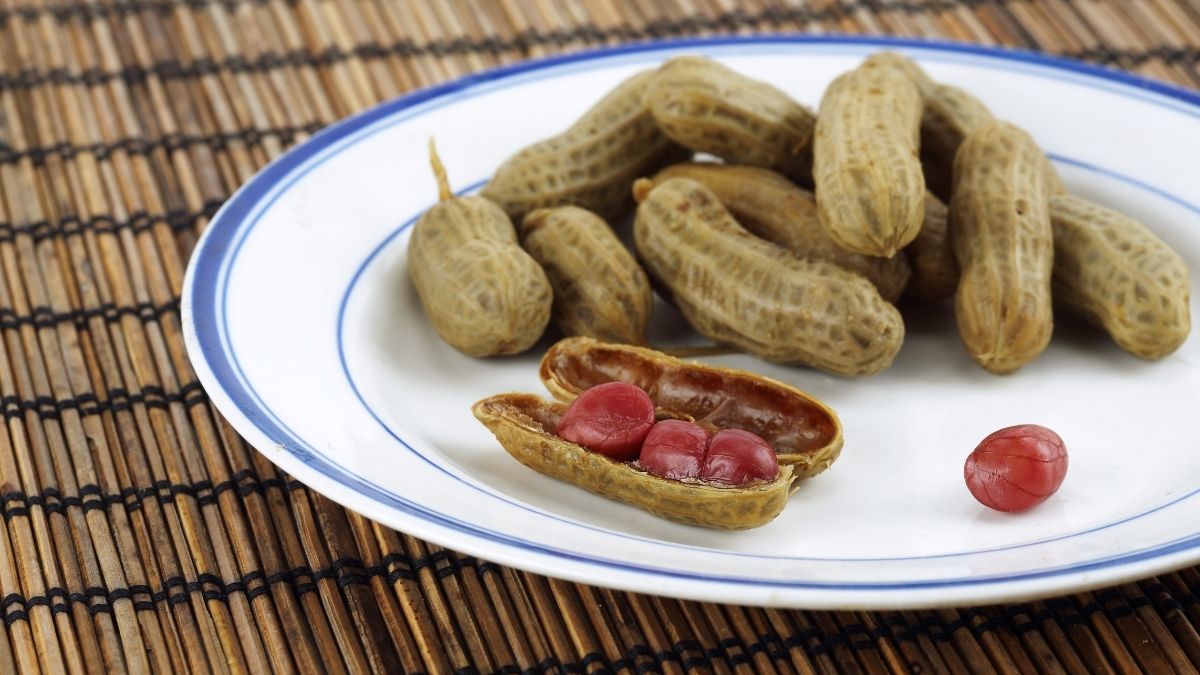Answer: Yes.

Boiled peanuts have long been considered culinary nuts served in both Asian and Western cuisines, and typically, these “nuts” are favored for their slight salty taste and are also commonly consumed as snacks. You’d find raw, shelled peanuts in the farmers’ market, while you can buy some ready-to-eat peanuts neatly packed and lined up on grocery shelves. Peanuts are especially popular in the southern states, where they seem to be a staple snack.
Peanuts, boiled or not, are de facto vegan. Peanuts aren’t real “nuts” but actually come from a family of legumes like soybeans, peas, and lentils. Since legumes are a type of vegetable, peanuts are naturally plant-based.
Since peanuts are a popular snack around the world, it’d be beneficial to know how healthy these “fake” nuts are and what their relations are to tree nuts and legumes. Also, peanut allergies are becoming more common today, so it’s also important for us to be aware of peanut allergens in general for our own safety.
Table of Contents
Peanuts Aren’t Nuts
Peanuts are also called groundnuts, goobers, pindars, or monkey nuts in other states and countries, but in a scientific light, peanuts don’t identify as “nuts” but instead belong to the botanical family Fabaceae (Leguminosae) of legumes. The scientific name for peanuts is Arachis hypogaea, which means “under the earth.”
According to the USDA Forest Service, real nuts are fruits with a specific definition. A nut is a dry, single-seeded fruit with high oil content and is stated as “a fruit whose ovary wall becomes hard at maturity.” Real nuts like chestnuts, walnuts, and almonds grow from tree blossoms, and their ovary walls become their protective shells, but peanuts are slightly different.
Although the peanut does produce arachis oil or peanut oil, it’s not a single-seeded fruit as it comes in a pod of 3 or 4, and it grows underground from ovary buds called “pegs.” The peanut plant also grows leaves and flowers that are bright orange-yellow and shaped like fans. Eventually, these petals fall off as an early sign of the plant’s ovulation.
Strictly, peanuts are legumes by name and nature, but they still share common traits with tree nuts such as taste, texture, proteins, and outer shells developed from the ovary.
Peanuts: Health Benefits
In the United States, peanuts are mostly eaten boiled or roasted, because cooked peanuts are more flavorful than when they’re raw. Salty, nutty, and with a tinge of sweetness, boiled peanuts make for a great snack or toppings for salads, desserts, and other meals. When boiled, peanuts are usually softer than other culinary nuts and possess a very thin, purplish skin inside the shell that is safe to eat.
Boiled peanuts aren’t too different from the raw version in terms of nutrition, and so an ounce of raw, unshelled peanuts contains:
- Calories: 162
- Fat: 13.5 grams
- Protein: 7 grams
- Carbs: 6 grams
- Fiber: 2.5 grams
- Vitamin B3 (niacin): 23% of the DV
- Vitamin B9 (folate): 17% of the DV
- Magnesium: 12% of the DV
Thanks to Healthline, we were able to note the beneficial fats that peanuts present for our health. Peanuts are a great source of mono- and polyunsaturated fats, the healthiest fats one could obtain from many other plant oils. Peanuts have very little saturated fats in their seeds and a fair amount of omega-6.
Mono and polyunsaturated fats, or simply unsaturated fats, are liquid at room temperature and help lower cholesterol in your blood if you would substitute them for your saturated fat intake. Monounsaturated fats are more prominent in peanuts than polyunsaturated, saturated, and omega-6 fats. They help reduce inflammations, improve good HDL cholesterol, and decrease the risk of death due to heart disease by 12% if consumed on average.
Peanuts are also a great source of plant proteins, of which 22 to 30% of their calories are made up of protein. So in a sample of 100 grams of unshelled, boiled peanuts, you could consume at least 22 g of protein without feeling too full. However, this protein-rich nature of peanuts is also responsible for why they’re highly allergenic, so always pay attention to your allergies first.
Peanuts are low in carbs, making them ideal for people with diabetes or simply trying to lose weight. With a bowl of fresh salad and sprinkles of peanuts, you would be able to prepare a good balance of plant carbs and proteins for your diet.
Peanuts are also rich in essential vitamins and minerals, such as niacin, folate, and magnesium. Niacin is beneficial in converting nutrients into energy, maintaining cholesterol and fats, creating and repairing DNA, and improving antioxidant effects. Folate is important for lactating women as it promotes healthy cell growth and functions. Finally, magnesium supports muscle and nerve function and energy production.
Peanuts, Tree Nuts, And Legume (Soybean) Allergens
Peanuts and tree nuts allergens are two of the most common sensitivities in the United States, while legume or soybean allergies are mostly found in children, but they do get over it as they mature. These allergies are generally widely separate, but patients showing common sensitivity responses from two or more of these allergies aren’t at all rare.
Tree Nuts
While tree nuts are small, delicate pieces of spice and texture, allergies to tree nuts are a big deal, and some well-known symptoms are:
- Nausea and vomiting
- Abdominal pain and cramps
- Difficulty swallowing
- Diarrhea
- Itching or swelling of the lips, tongue, throat, skin, or other areas
- Anaphylaxis
According to the Northeast Allergy center, anaphylaxis is a severe allergic reaction that triggers hives, wheezing, vomiting, rapid heartbeat, seizing, rash on the skin, trouble breathing, and/or chest pain, and individuals who are allergic to tree nuts have had steady population growth since 2018 to 2019 where over 4 million Americans pose allergic reactions to tree nuts.
Since there is a wide variety of tree nuts, people have varying degrees of sensitivity to particular tree nuts. While others may find themselves severely affected by almonds, they may find walnuts less antagonizing. People with tree nut allergies may also be sensitive to peanuts, but the theory is up for more speculation.
In other words, people who may be starkly sensitive to almonds may still need to watch out for walnuts and peanuts, as the probability of being sensitive to either or both “nuts” is highly possible. First, a skin test may be a good idea to identify allergic reactions.
Peanuts
As we’ve already discussed, peanuts aren’t related to tree nuts but are considered legumes; therefore, they are labeled separately in most edible products. Despite their similarities in taste and texture, peanuts and tree nuts have different biological compositions, especially their types of fats. Peanuts and tree nuts share some plant proteins; therefore, cross-reactivity, or the possibility of being simultaneously allergic to both, stands out.
According to VeryWellHealth, the majority of individuals with peanut allergies can have some tree nuts in their diets, but these same individuals may be twice more susceptible to tree nut allergies than those who don’t have allergies at all. Therefore, it’s best to take advice from allergists first before taking a bag of cashews with you.
Also, from the MayoClinic, peanut allergies share the same symptoms as tree nut allergies, including anaphylaxis. This is why cross-reactivity is hard to identify within allergic individuals and would take an expert to know which exactly the person is sensitive to.
Legumes (Soybeans)
Although peanuts belong to the family of legumes, people who suffer from cross-reactive allergies are rare. According to one relevant study, 35% of people allergic to peanuts would also be allergic to particular legumes, sometimes soybeans, but not necessarily.
However, only 5% of these people would show allergic symptoms to the legumes, meaning that severe cross-reactivity between peanuts and legumes is very uncommon. So you can still eat a handful of good, fresh legumes despite being allergic to peanuts.
Soy allergy is most common in children, especially those in the breastfeeding stage, but they do get past the point over time. However, it would be best to consult a pediatrician when symptoms persist. The same may not be said for the legume lupine, though. Lupin or lupine is thought to have a higher risk of inducing an allergic reaction in people allergic to peanuts, but more research is required to explain why. However, it’s notable evidence that about half of people allergic to peanuts are allergic to lupine, but they won’t necessarily develop any symptoms or severe reactions, at least not all of them.
Lupine grows as a tall stalk with purple, tapering flowers, and its seeds are edible and are commonly used in making gluten-free flour. They can also be found in vegan products such as fake sausages, dairy-free ice cream, and tempeh. So you might encounter this legume ingredient quite a lot, and it makes it important enough to know whether you would react to lupine or not.
Conclusion
Boiled nuts are vegan, and they’re very nutritious and delicious.
They’re also affordable and easy to prepare. Just soak them in boiling water for about an hour, cool them, and then they’re ready to eat or serve as toppings on your salads, “meats,” and desserts.
Despite the versatility and popularity of peanuts, always make it a point to know whether you or the person you’re serving have peanut allergies because allergies are uncomfortable at best and dangerous at worst.




